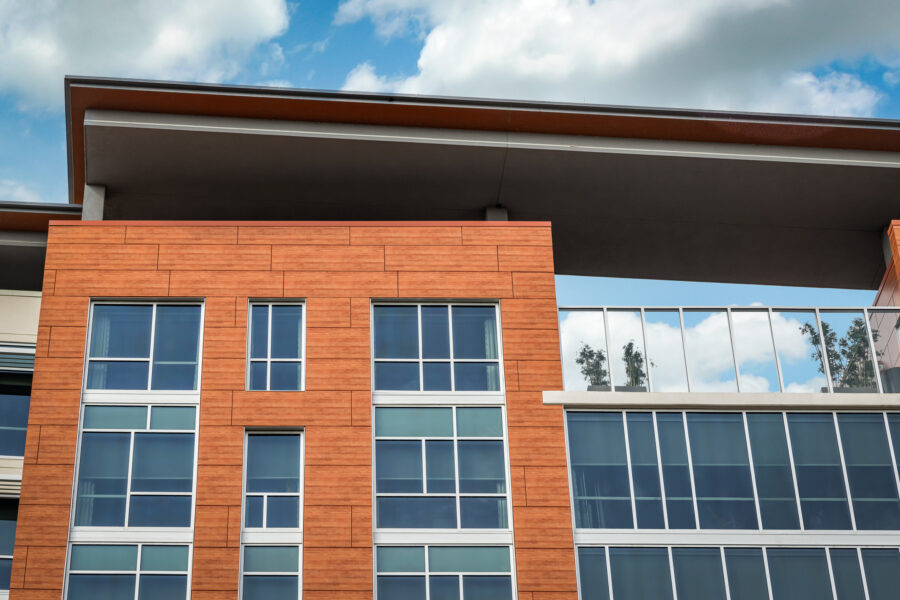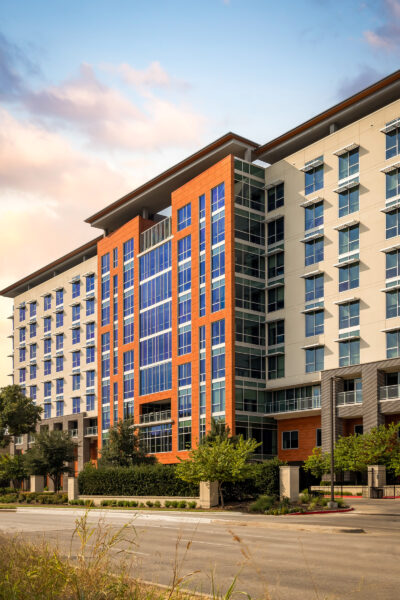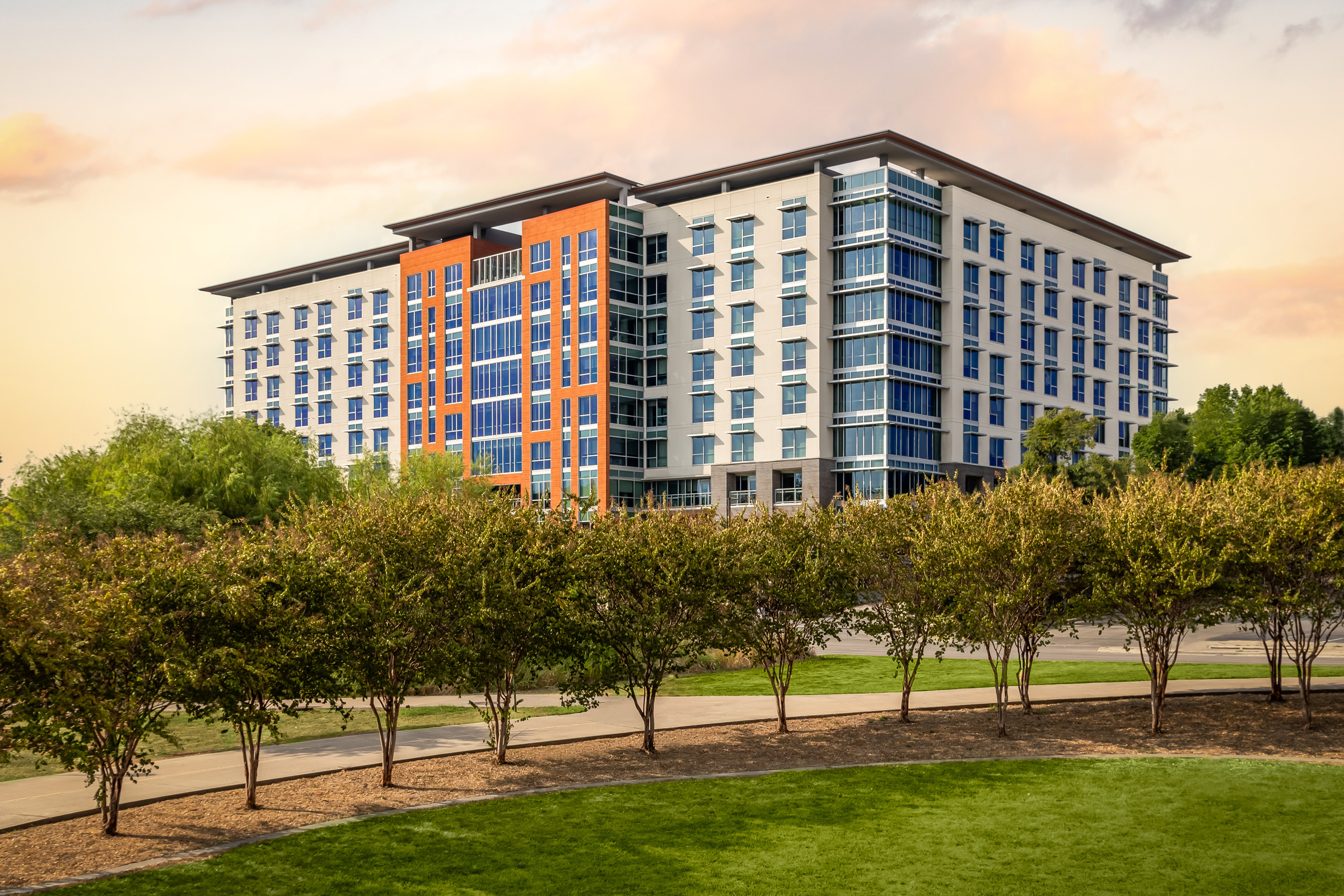Story at a glance:
- Lightweight MCM can be fabricated into complex shapes in a wide array of colors.
- Combined with insulation and air water barriers, MCM creates a high-performance building envelope.
- You can even get the look of wood grains, marble, rusted steel, and brushed metal.
Every year thousands of projects go up across North America that showcase the versatility of sustainable MCM. Architects have found that they can push the boundaries on design. General contractors have found they can navigate budgets and lead times.
Fabricators have found they can create simple to install panels with relative ease. More and more, projects both big and small have turned to MCM to do what other building materials sometimes can’t. It’s no wonder MCM is finding its way into specifications, from details to entire envelopes, and it’s time to master composite.
Metal composite material (MCM) shouldn’t be intimidating. Simply explained, two thin sheets of metal are used to sandwich a thermoplastic core. There are a few types of metal skins available, if and how they are finished can change, and there are two types of cores. But in the end, it’s just metal, core, metal, and you have an MCM panel.
A Little Background
The process of manufacturing MCM is highly engineered. The basic layers are bonded under heat, pressure, and tension; no adhesives are used. These lightweight sheets can be fabricated into complex shapes, finished in a nearly endless array of colors and designs, and provide a steadfast cladding option that, combined with insulation and air water barriers, creates a high-performance building envelope that’s able to meet your design needs.
Introduced to the world more than 50 years ago, American manufacturing and architectural use of MCM has taken hold over the last three decades. First incorporated into gas station canopies, painted aluminum composite material (ACM) offered a lightweight, uniform look for the biggest petroleum brands who needed easy fabrication, reliability, and custom matched finishes for their corporate identity colors.
While the term ACM is still often used, the name of the product category has evolved to MCM to encompass more than just aluminum. Natural metals like copper, zinc, stainless steel, and titanium are all now made more affordable and easier to fabricate with the advent of composite technologies without sacrificing on the rich visual impact. Advancements in image transfer process have also made way for incredible patterns that mimic the look of wood grains, marble, rusted steel, and brushed metal without the weight, maintenance, or expense.
A Cost-Effective Cladding Solution

Quality MCM is an investment that helps reduce the bottom line—one that design-build professionals have turned to for decades. Panels can be fabricated in the shop and installed faster than alternative products for the building envelope. These systems could require less structural investments, like reduced steel needs because of the lighter load in the wall assembly. Though only one-fourth to one-third as much metal as comparable one-eighth inch sheet metal, composites impressively retain their rigidity and strength.
When compared to sheets of solid metal, composite remains flat and won’t “oil can,” a visual distortion that looks like waves. Cleaning can be as simple as a freshwater rinse, providing lower maintenance costs.
A properly installed system can give you a look that lasts, with some finishes warranted for 30 years. Able to facilitate complex designs on a budget, MCM sheets can be purchased in a wide array of stock sizes or custom cut to custom lengths to reduce waste and maximize yield.
Understanding the Specification

In practice MCM specifications can be found in a number of sections, which can make the spec harder to navigate. Using the Construction Specifier Institute as guidance, we recommend section 07.42.13. Division 7: Thermal and Moisture Protection, section 42: Wall Panels, subsection 13: Metal Wall Panels. If you want to drill down even further, 23: Metal Composite Material Wall Panels.
MCM is just one component of the wall assembly system. To ensure clarity we recommend discussing the MCM requirements independent of the other wall components, such as air water barriers and insulation. Here are some common MCM considerations.
Sizing. The standard product features aluminum skins 0.02-inch (0.5 millimeters) thick. Heavy-duty 0.32-inch (0.8 millimeters) skins are also available. The finished product is available in thicknesses of 3, 4, or 6 millimeters, with 4 millimeters being the most commonly used. Standard panel dimensions are 50 or 62 inches wide and 146 or 196 inches long, with custom sizes also available. Panel lengths can range from 6 to 24 feet.
Core. The thermoplastic core can be a traditional polyethylene (PE) or fire-resistant (FR). PE is roughly two-thirds the weight of FR. Both are rated Class A under the ASTM E84. MCM with FR core material has been used as a component in a variety of wall assemblies that have successfully passed the American NFPA 285 and Canadian ULC- S134. For this reason FR core material is recommended when MCM is applied over 40 foot from grade.
Finishes. Paint applications and paint systems have evolved dramatically over the last few decades. Look for a continuous coil coating method such as a reverse roller coat or the more precise die coating for a uniform look that holds up over time. The expected performance of the finish is also dependent on the paint system. Fluoropolymers such as PVDF and FEVE meet the performance standard of AAMA 2605. Second generation FEVE is thermoset and boasts the widest gloss range, from 6 up to 70. Finish is more than just the color and looking only at a color code could be a costly mistake.
Warranty. Finish warranties on painted ACM can range from 10, 20, to even 30 years. But not all warranties are created equal. Look beyond the number of years with your finish warranty and you’ll find some stark differences. Warranties that limit restitution to material only, or even a prorated material cost, leave the bulk of remediation expense on the property owner for non-performing materials. Look for an in situ warranty. The difference in value is exponential should you ever need to execute a warranty claim.
Reports. MCM manufacturers are ready to supply relevant reporting, often found on a technical resources page. Documents like product data sheets, safety data sheets, environmental product declaration, product transparency document, notes on LEED support, regional reports and fire test summary reports should be made readily available.
Fire Safety
As with all building products, specifying MCM comes with compliance responsibilities. Use third-party evaluations like Warnock Hersey (WH-ETL) to gauge a quality product. And keep in mind, the cladding material is only one part of the wall assembly. When specifying a wall, in particular one above 40 foot from grade, it’s important to look for wall assembly systems tested in accordance with building codes to ensure fire safety compliance. Full scale wall assembly tests like the American NFPA 285 and the Canadian ULC-S134 may be required for multi-story structures. Always follow the code.
Working with MCM
Metal composite materials are lighter in weight, easier to fabricate into complex forms, and easier to install than traditional materials while still offering flatness, durability, stability, vibration damping, and ease of maintenance. Cutting, grooving, punching, drilling, bending, rolling, and many other fabrication techniques are easy to perform because of the thermoplastic core. A CNC router makes efficient work and ensures uniform fabrication. More detailed techniques on the specific types of MCM can be found in your manufacturers fabrication manual.
The superior fabrication capabilities of MCM enable architectural possibilities ranging from advanced rainscreens designed to withstand hurricane force-winds to extraordinary innovations in sound engineering. MCM enables complex forms that would be prohibitively expensive or outright impossible to create using other materials, expanding what is possible with design.
Often the face of a building, MCM is a part of cladding systems that fall into one of two general categories, sealed and rainscreen. There are multiple factors that should be evaluated when determining the ideal cladding system for your specific project. Some considerations include: the project environment, aesthetic needs, wall performance and code requirements as well as the project budget.
Sealed systems are designed to create an outward layer of protection against the elements with water-resistant cladding and sealed joints. Two common examples of sealed systems are referred to as wet seal and dry seal. Rainscreen systems manage wind and water intrusion in a two-layer system. Most of the water intrusion is managed in the outer cladding layer, but an interior air water barrier (AWB) is required as a second line of defense. Rainscreens can be a pressure equalized rainscreen (PER) system or a drained and back ventilated rainscreen (DBVR) system.
Ready to Get Started?
MCM manufacturers offers several ways to learn more, including AIA-Certified lunch-and-learn courses, literature and samples, and can even help connect you with the names of local fabricators.
Companies like ALPOLIC take pride in their service and support and stand ready to help direct you to your best solution. Whatever the role on the design and build team, your MCM manufacturer should be there through the entire process, just a phone call away. A specification is a document that should function as a road map to bring an architectural vision to life. Build your next project with the help of metal composite materials.


